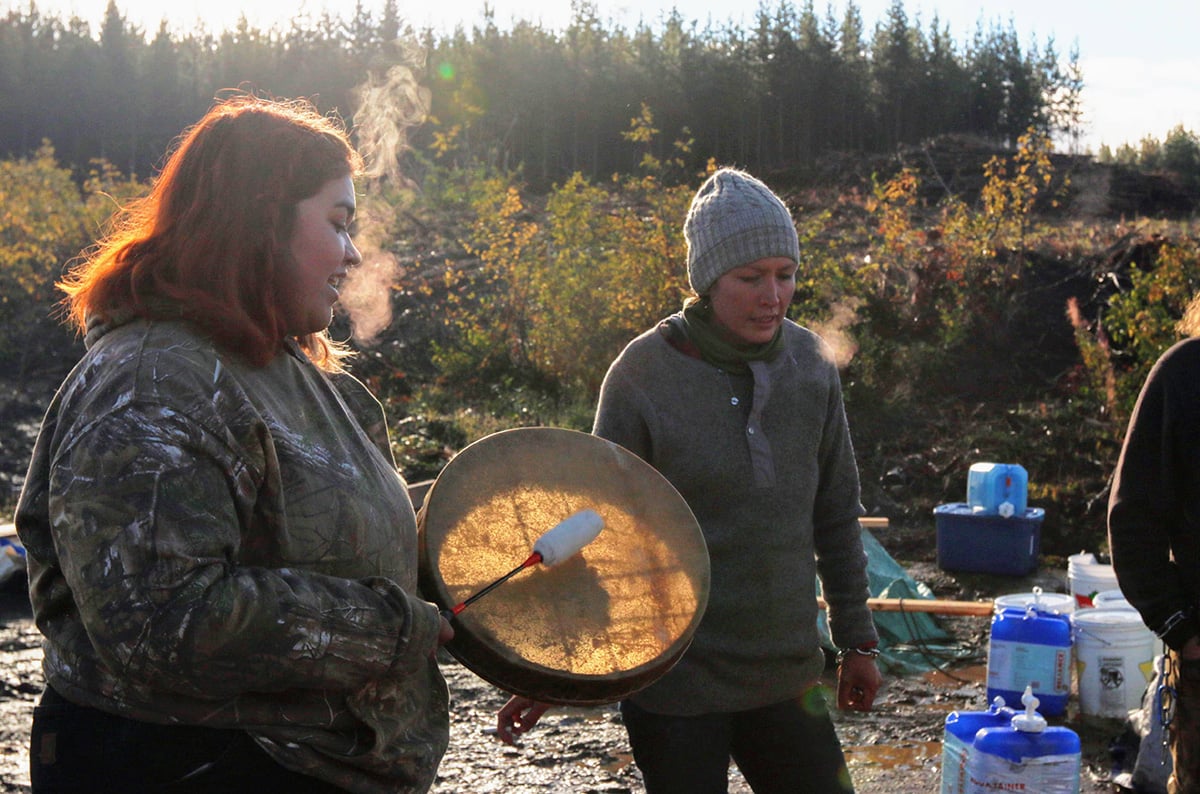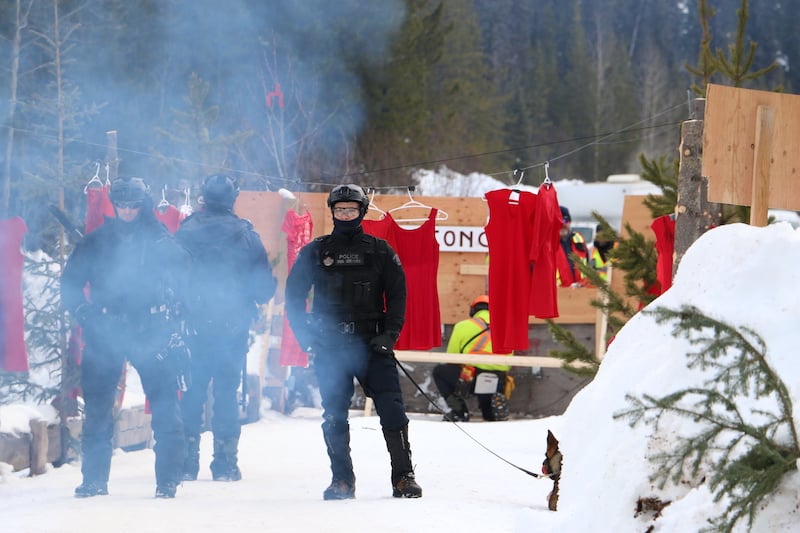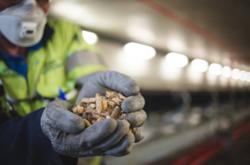RCMP officers considered shooting a security camera and sending a police dog to pull people out of a small structure as they moved to make arrests on Wet’suwet’en territory in November 2021, according to testimony in a B.C. Supreme Court hearing.
The force also used “lethal-force overwatch” — snipers armed with rifles — during the high-profile enforcement, according to officers with a specialized RCMP response team meant to resolve high-risk situations.
The revelations came as RCMP witnesses began testifying at a hearing on the Nov. 19, 2021, police response to Indigenous land defenders who had occupied two small structures along the Coastal GasLink pipeline route. The hearing follows Justice Michael Tammen’s verdict, Friday, that there is sufficient evidence to convict three people charged during the raid with criminal contempt of court.
Immediately following the decision, Tammen moved to consider an application to dismiss the charges based on police conduct during the arrests. The defendants say they experienced “widespread Charter violations stemming from police misconduct” and “disproportionate and excessive use of force,” according to a statement issued by members of the Gidimt’en Clan.
Among those arrested inside a “tiny house” located next to the pipeline route was Sleydo’, who also goes by Molly Wickham. A prominent figure in the Wet’suwet’en Nation’s years-long opposition to the project, Sleydo’ was arrested along with Shaylynn Sampson, who is Gitxsan, and several others, including two journalists. One of the journalists, Amber Bracken, is now suing the RCMP over her arrest and detention.
The BC RCMP’s Community-Industry Response Group, a unit formed in response to resource extraction conflicts, is also currently under investigation by Canada’s police watchdog after allegations of widespread misconduct during arrests. The unit was formed in 2017.
Sleydo’ and Sampson stood trial last week alongside Corey Jocko, who is Haudenosaunee. Jocko was occupying a second small structure located less than a kilometre down the pipeline route at a site where Coastal GasLink was preparing to drill under the Morice River. Known as Wedzin Kwa in the Wet’suwet’en language, the river has been central to the nation’s concerns over pipeline construction through its traditional territory.
Wet’suwet’en hereditary leadership first voiced opposition to pipelines more than a decade ago, before Coastal GasLink was proposed. Coastal GasLink has pointed to impact benefit agreements, signed with five of the nation’s six band councils, as evidence of support for the project.
Five years ago, the B.C. Supreme Court granted Coastal GasLink an injunction that prohibits anyone from blocking access roads or work sites used for pipeline construction. Since then, the RCMP have arrested dozens of people in several highly publicized police raids to clear blockades on the Morice Forest Service Road, a main access route to the pipeline corridor through Wet’suwet’en territory.
While Coastal GasLink has declined to pursue legal action against those arrested under its injunction, in 2022 the BC Prosecution Service announced it would lay criminal contempt charges against 19 people arrested during the two-day police action on Nov. 18 and 19, 2021. Some have since pleaded guilty. In November, one person was found not guilty in the first trial of the criminal contempt charges.
To meet the threshold of criminal contempt, the Crown must prove that someone knew about a court order and deliberately defied it, degrading the court’s authority.
The RCMP’s use of force in the arrests — which has included deploying officers in military-style uniforms, carrying assault rifles and using police dogs — has long been cause for concern for Wet’suwet’en hereditary leaders.
The RCMP received criticism in 2019 following its first enforcement on Wet’suwet’en territory, after the Guardian reported that officers had used snipers prepared to use deadly force against those defying police. At the time, then-Indigenous services minister Marc Miller called the news “concerning” and suggested the federal government would review the practice.
But the force has continued to use snipers during arrests on Wet’suwet’en territory. In February 2020, The Tyee observed what appeared to be officers armed with rifles dropped by helicopter onto a hillside overlooking the area where police arrested seven people outside the Unist’ot’en Healing Centre.

In a statement Tuesday, Amnesty International said it “condemned” the court’s decision about the criminal contempt charges.
“Amnesty International’s research found numerous violations of the rights of Wet’suwet’en land defenders and their supporters during the large-scale police raids, arrests and detentions,” said Ketty Nivyabandi, secretary-general of Amnesty International Canada’s English-speaking section.
“Sleydo’ (Molly Wickham), Shaylynn Sampson and Corey (Jayochee) Jocko are being wronged twice by Canadian authorities; first by permitting pipeline construction to proceed without their free, prior and informed consent, and now by prosecuting them for peacefully exercising their rights to protect their land. Canadian authorities are punishing Indigenous land defenders instead of holding to account those responsible for violating their human rights.”
Officer testimony
On Friday, the court heard from Cpl. Sebastien Pilote and Sgt. Ryan Arnold, who led the RCMP’s Emergency Response Team, or ERT, as they arrested people at the two structures on Nov. 19, 2021.
The officers testified that they left their vehicles about 63 kilometres down the Morice Forest Service Road and continued on foot more than two kilometres down the Marten Forest Service Road, which was blocked by snow.
Once at the location where the Marten intersects the pipeline route, Pilote stayed at the tiny house where Sleydo’ and Sampson were located, he said, while Arnold continued with another team about 800 metres down the pipeline route to where Jocko and several others were located.
Arnold testified that ERT teams generally include a sniper, a medic, a rope specialist and a breacher — someone specialized in breaking into structures. While an ERT command team would normally include a negotiator, he said that he wasn’t aware of one being used that day.
But he said that RCMP snipers, carrying carbine assault rifles modified to make them more effective at longer distances, were present to provide “a quick response unit” for officers making the arrests.
“Our understanding was there was potential for there to be a large number of protesters and the Tactical Support Group, when they have to go potentially hands-on with a large crowd, they’re typically not armed with a firearm,” Arnold said. “We were there to provide lethal-force overwatch for the tac team to go hands-on with people who need to be arrested.”
ERT officers weren’t wearing body cameras and the unit doesn’t use them, Pilote testified.
According to a transcript of radio communication during the enforcement, when Pilote spotted what he described as a camera on the exterior of the tiny house where Sleydo’ and Sampson were located, he requested permission to fire a weapon to disable it. He was instead given instructions to manually disable the exterior device by cutting its cable.
Pilote testified that disabling the camera was meant to ensure officer safety.
“We’ve seen in the past where people inside the structure monitor our movement... or broadcast our movement to other people,” he said. “That’s why we usually let them see the police and then disable the camera.”
The officers discussed whether it was necessary to obtain a warrant to enter the cabins but ultimately received instructions from command that the injunction was sufficient to make the arrests, according to radio communications shared with the court. While officers specializing in entering structures were on scene, the court heard that they did not carry proper “breaching” devices, such as chainsaws equipped with depth gauges.
Instead, officers used heavy-duty axes, a sledgehammer and a chainsaw they found lying near the buildings to break down the doors. In the cabin where Sleydo’ and Sampson were located, Pilote used a chainsaw to cut through a two-by-six plank used to reinforce the door, as a police dog barked loudly, according to video played for the court.
Once the door was breached, Pilote stood in the doorway, pointing a rifle with a flashlight in the “ready position,” which he testified meant a slightly lowered angle. He described the barking police dog as a tool to change a person’s behaviour or track anyone who runs away.
“The behaviour you observed was people standing on the beds with their hands up,” defence lawyer Quinn Candler said. “What part of that behaviour would you like modified, either by the weapon you were carrying or by the dog that was barking?”
Pilote responded that he wanted the occupants to come out of the building.
But behaviour modification wasn’t the dog’s only purpose, Candler suggested.
“You initially wanted to send the police dog in to drag people out of the cabin, right?” Candler said.
The attorney read from a transcript of radio communications between Pilote and command, in which the officer suggested sending the dog in.
“Six occupants in cabin, one refusing to come out. So we’re going to have to go in. We can use the dog or we can use people,” Pilote said over the radio, to which someone replied that they’d prefer not to use the dog and asked for a recommendation.
“It’s a fairly tight spot. Obviously, people will be less invasive, but it’s not going to be pretty,” Pilote responded.
On the stand, Pilote testified that he was providing two options. Those in command ultimately chose the latter, and officers entered the tiny house and arrested people without incident.
At the second cabin, where police used large axes to break down the door, Arnold testified that they found four people sitting “as far from the door as they could have been” with their hands up. The group was told they were under arrest and left the building when asked, he said.
The hearing, which was expected to wrap up this week, is now expected to continue well beyond its currently scheduled dates. Remaining witnesses include five RCMP officers, in addition to Sleydo’, Sampson and Jocko.
“It sounds to me like there’s no question we’re going to need one more full week,” Tammen said as testimony wrapped up Monday. “It might end up being another two weeks.” ![]()
Read more: Indigenous, Rights + Justice

















Tyee Commenting Guidelines
Comments that violate guidelines risk being deleted, and violations may result in a temporary or permanent user ban. Maintain the spirit of good conversation to stay in the discussion and be patient with moderators. Comments are reviewed regularly but not in real time.
Do:
Do not: